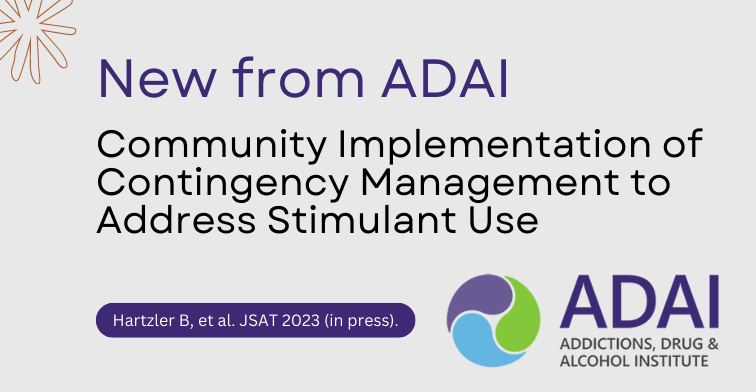New from ADAI: Community Implementation of Contingency Management to Address Stimulant Use (Hartzler, 2023)
02/08/2023
A new publication by ADAI Research Associate Professor Bryan Hartzler, PhD and colleagues reports outcomes of an interagency partnership among the Northwest ATTC, Oregon Health Authority, and Oregon Recovery and Treatment Centers, LLC. This partnership involved an intensive technical assistance project in which opioid treatment programs successfully implemented customized contingency management programming to increase stimulant abstinence among their clientele.
What’s the Question?
While the search for medications to address stimulant use disorder remains elusive, contingency management (CM) is a behavior therapy for which there is strong evidence of effectiveness in improving treatment adherence among persons with stimulant use disorder. Despite its clinical effectiveness, treatment organizations have historically shown reluctance about its adoption due to a range of implementation concerns related to cost, logistics, philosophical incongruence, and policy barriers.
How might such barriers be overcome? Intensive technical assistance (TA) efforts, such as those offered by the UW Center for Advancing Addiction Health Services under the direction of Dr. Hartzler, provide a feasible pathway for many in the treatment community. A key component of these TA efforts is collaborative work to customize CM programming to fit the local needs and resources of a treatment setting, which then increases likelihood of initial success in its implementation and capability to be sustained over time.
How Was This Partnership Undertaken?
In this project, sponsorship was provided by Oregon Health Authority via the State Opioid Response grant and Oregon Recovery and Treatment Centers, LLC identified the Medford Treatment Center—an opioid treatment program in southern Oregon—as an initial treatment program at which CM would be implemented. On behalf of Northwest ATTC, Dr. Hartzler served as the TA provider.
As for what was provided, a robust TA package was delivered over the course of 12 months. This included a comprehensive online training course previously developed and availed by Dr. Hartzler and colleagues through the Northwest ATTC, and a series of facilitated TA processes encompassing the collaborative design of CM programming, assembly of a local implementation team, virtual skills-focused coaching of clinical staff to a fidelity criterion to assure their readiness, creation of a local resource library, ongoing consultation during an initial six-month period of implementation, and evaluation of clinical outcomes.
As a product of its collaborative design, Medford Treatment Center implemented a CM paradigm involving ‘escalating vouchers’ in which clients who continually test negative for stimulant use (via urinalysis) received gift cards of increasing value over time. Broad client eligibility criteria were employed, with this CM paradigm implemented with all clients who evidenced recent stimulant use.
To ensure that clinical staff were implementation-ready, a six-hour skills-focused virtual coaching process concluded with each staff member completing a role-play with a standardized patient as a ‘readiness assessment.’ These were observed by Dr. Hartzler in real-time, and scored according to a validated CM fidelity instrument so that performance-based feedback could be immediately provided. All individual staff members met or exceeded an a priori fidelity benchmark signifying their readiness to implement CM with their clients in the future.
Was the CM Programming Effective?
Over a six-month period, 73 stimulant-using clients were enrolled in the CM programming at Medford Treatment Center. Among them, the rate of stimulant-free urine drug screens was 11% greater than that of 120 clients previously enrolled in services at Medford Treatment Center who were not exposed to the CM programming.
While stimulant abstinence was targeted as the client behavior to be reinforced, a secondary therapeutic benefit was also found in that the rate of six-month service retention was 14% greater among CM-enrolled clients than among 162 CM-ineligible (i.e., stimulant non-using) clients concurrently enrolled in services.
On the basis of these findings, and their collective implementation experiences over this six-month period, the leadership of Medford Treatment Center chose to sustain this CM programming as part of its routine clinical services thereafter.
What Are the Implications for the Workforce?
Successes of this project include the delivery of a TA package that sufficiently prepared a community treatment program to implement CM programming, and documentation of the clinical effectiveness of that CM programming in terms of the targeted client behavior and secondary therapeutic benefit. Perhaps of greatest importance was the eventual decision by leadership of the treatment program to sustain the CM programming, which has since continued for 18 months—and counting. . .
While the published study describes the project involving Medford Treatment Center, it is noteworthy that the same TA package was subsequently delivered with additional opioid treatment programs in Oregon. This has similarly resulted in initial implementation successes, and eventuated in each of those opioid treatment programs also choosing to sustain their CM programming thereafter. Clearly, these are reasons for optimism about what is possible with community-based implementation of CM, particularly if settings are empowered to help sculpt CM programming that is compatible with their local needs.
As poor treatment adherence among stimulant-using clients continues to pose challenging dilemmas for many treatment settings, CM remains an effective, albeit underutilized, behavior therapy to address such challenges. In documenting this effort, Dr. Hartzler and colleagues have provided a model for how TA can enable the design and implementation of CM programming that is customized to local needs and resources, clinically effective in reducing stimulant use, and sustainable for community treatment settings.
Citation: Hartzler B, et al. Community implementation of contingency management to address stimulant use. Journal of Substance Use and Addiction Treatment 2023 (in press). [doi: 10.1016/j.josat.2022.208941]





